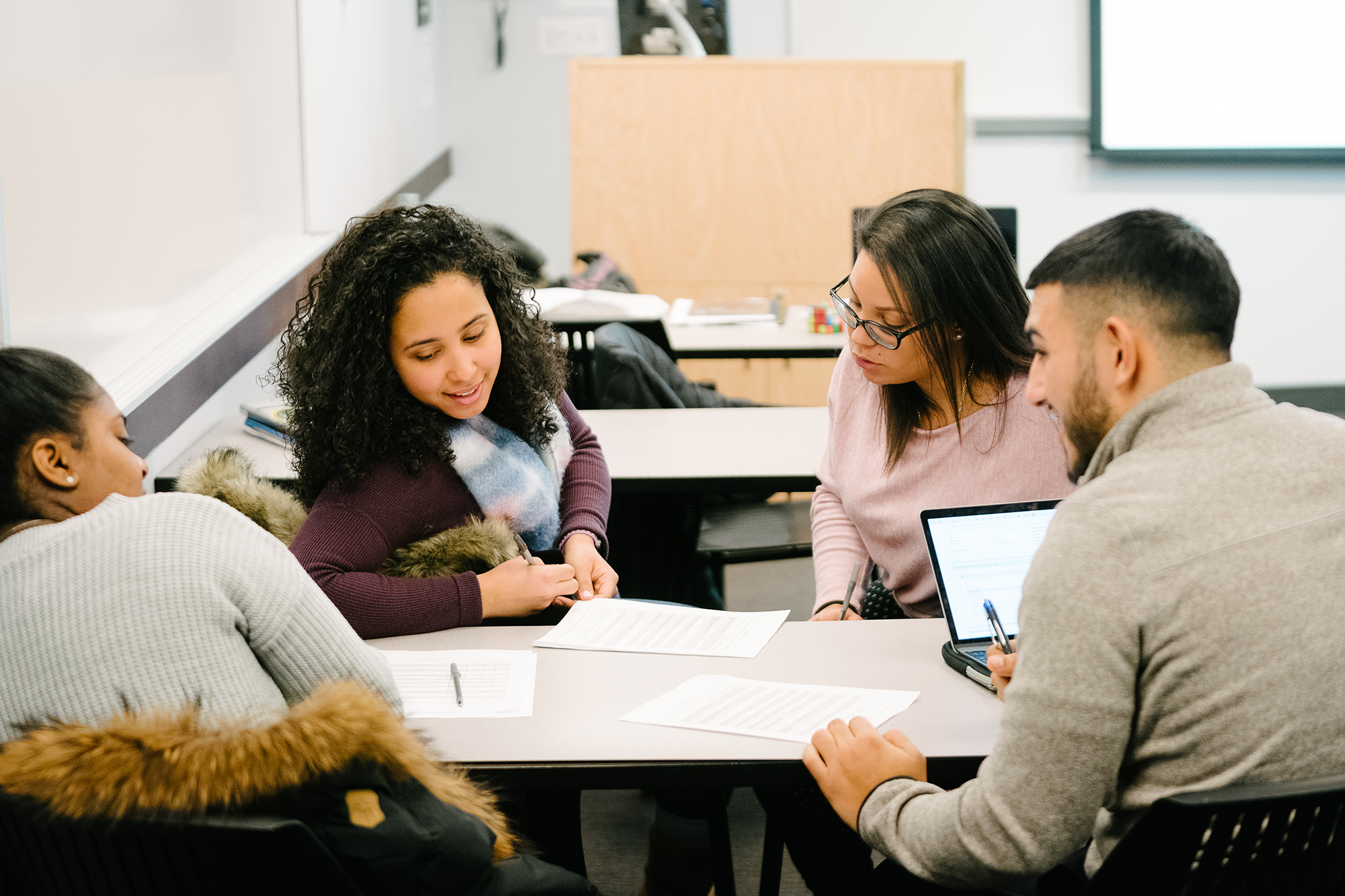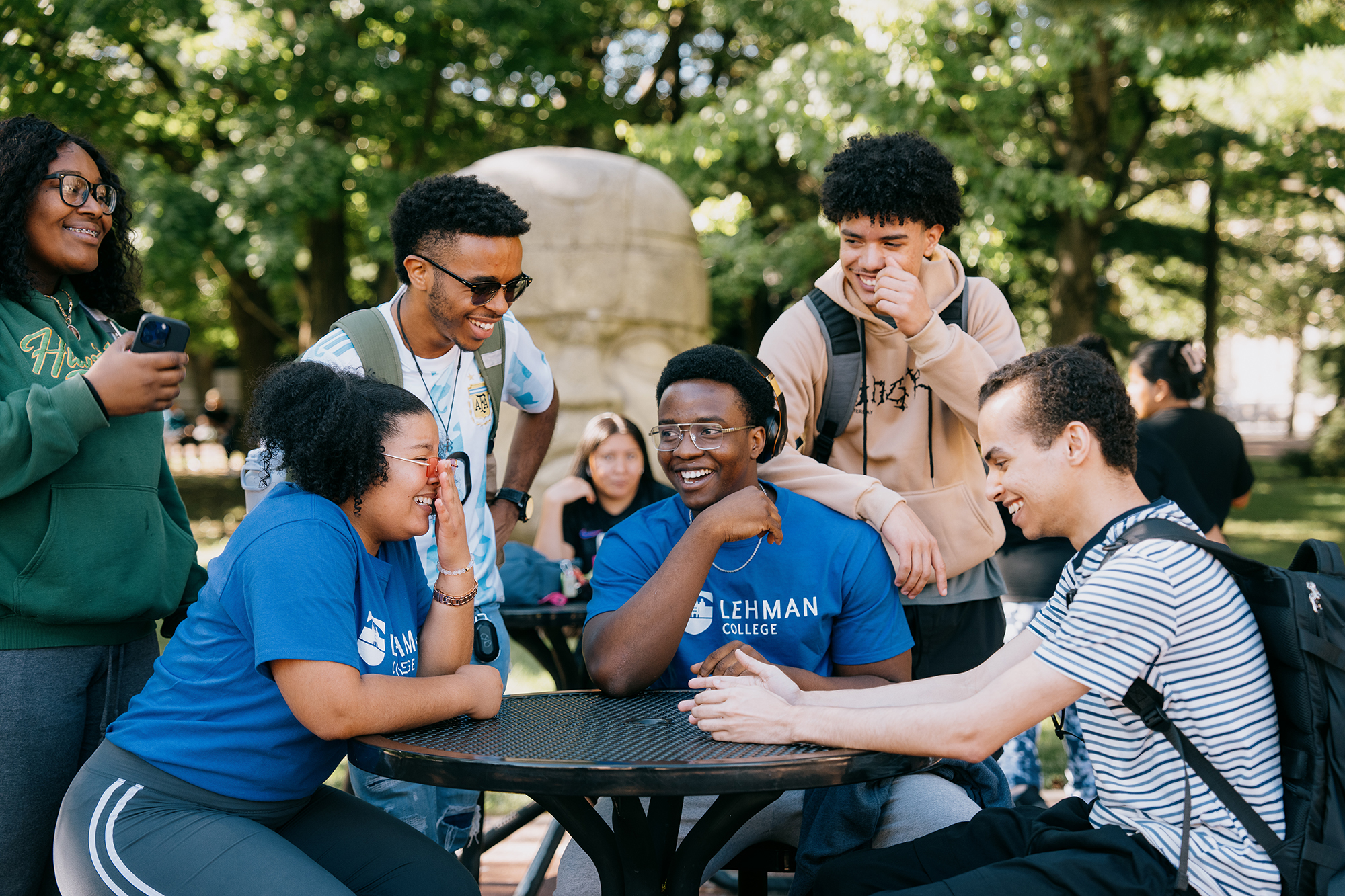 E-mail address: gabriel@lehman.cuny.edu
E-mail address: gabriel@lehman.cuny.edu
Phone Number: 718-960-8733
Office: Davis Hall 236 (Lab: Davis Hall 221A, 718-960-8240)
Rank: Assistant Professor
CONTACT
-
Department of Biological Sciences
718-960-8235
Davis Hall, Room 217Office Hours
Monday - Friday, 9:00am-5:00pm
Faculty Gabriel O. Aisemberg
- M. Sci., Ph.D., Univ. of Buenos Aires, Argentina
Hox Genes as Molecular Determinants of Neuronal Development
The body of an animal has an amazingly large variety of cell types with very different shapes and functions. However, all the cells of an animal contain the same genes. During embryonic development, cells become different because they start to express different sets of genes. As a consequence, only a relatively small fraction of all the genes are expressed in each individual cell. Transcription factors are regulatory genes that play a crucial role in defining cell types by controlling the expression of other genes. The Hox genes are a well-studied family of transcription factors that code for proteins containing a DNA-binding motif called the homeobox or homeodomain. The Hox genes seem to be present in all animals, including organisms that are as diverse as humans, insects, worms and jellyfish. Early during embryonic development, the Hox genes specify positional information along the anterior-posterior body axis. At later stages of development, the Hox genes are also expressed within specific domains of the nervous system.
Of all the organ systems in an animal, the nervous system contains the largest variety of cell shapes and behaviors. The mechanisms that generate this diversity determine nervous system development and pathology. Since the discovery of the Hox genes in 1984, our knowledge of embryonic development has improved tremendously. However, we have a more limited understanding of how Hox genes function at the cellular level, particularly in the nervous system. As a consequence, it is very valuable to be able to examine and manipulate the expression of these genes in individual, identified neurons whose properties are well known. For these reasons, we are studying the Hox genes in the leech Hirudo medicinalis, an organism well suited for neurobiological research. Leeches have a simple nervous system with large, hardy neurons that are easy to study.
The goal of our research is to examine the functions of Hox genes in the development of the central nervous system. There are at least nine different leech Hox (Lox) genes. Some of these genes have been cloned, allowing us to raise antibodies against their proteins and study their expression. The Lox genes are expressed in different but overlapping subsets of neurons within the central nervous system of the embryo, where they may act in a combinatorial way to determine neuronal identities. We are currently examining the normal patterns of expression of Lox genes in the nervous system, as well as the effects of experimentally altering their expression in neurons. Part of this work is carried out as a collaboration with Eduardo Macagno of Columbia University.
"NCBI PubMed Search of "G. O. Aisemberg"
New Electrical Properties of Neurons Induced by a Homeoprotein. G. O. Aisemberg, T. R. Gershon, and E. R. Macagno. J. Neurobiol. 33, 11-17 (1997). Abstract
- J Neurobiol 1997 Jul;33(1):11-17
- New electrical properties of neurons induced by a homeoprotein.
- Aisemberg GO, Gershon TR, Macagno ER
Department of Biological Sciences, Columbia University, New York, New York 10027, USA.
To explore possible neurogenic functions of the genes of the Hox/HOM complexes, we injected the mRNA from the leech homeobox genes Lox1 and Lox4 into adult neurons that normally do not express them. The ectopic expression of Lox1 induced a specific transformation in the electrical properties of certain identified neurons: action potential amplitude increased about threefold after the injections. This effect of Lox1 expression was restricted, among cell types examined, to the anterior pagoda neurons (APs) and the nut neurons. This effect was also restricted to Lox1 ectopic expression; the action potentials of APs and nut neurons were not enlarged when the mRNAs of either Lox4, another leech Hox/HOM gene, or beta-galactosidase were injected. Lox1 mRNA injection did not affect the resting potential, input resistance, or axonal morphology of the transformed APs, raising the possibility that it acts via the modification of voltage-dependent ion channels. Thus, a specific homeobox gene can transform key neuronal characteristics in a cell-specific manner. We may thus add electrophysiologic properties to other aspects of neuronal identity determined by homeobox gene expression.
PMID: 9212066, UI: 97355585 A Novel Homeobox Cluster Expressed in Repeated Structures of the Midgut. J. Wysocka-Diller, G. O. Aisemberg, and E. R. Macagno. Dev. Biol. 171, 439-447 (1995). Abstract
- Dev Biol 1995 Oct;171(2):439-447
- A novel homeobox cluster expressed in repeated structures of the midgut.
- Wysocka-Diller J, Aisemberg GO, Macagno ER
Department of Biological Sciences, Columbia University, New York, New York 10027, USA.
A gene cluster (LOX3-C) containing three duplicated homeobox sequences (Lox3A, Lox3B, and Lox3C) was characterized in the leech Hirudo medicinalis. The leech homeoboxes have a limited homology to those of Antennapedia-class genes, but do not have homologs among currently characterized insect genes. The Lox3 genes belong to a new family, named Xlox, that also includes genes from mouse, rat, frog, and a distantly related leech, Helobdella triserialis. All members of the Xlox family are expressed in specific regions of the embryonic gut, where they seem to affect morphogenesis and cell differentiation. The three homeoboxes of LOX3-C described here are contained within nearly identical direct tandem repeats. The LOX3-C region produces at least two transcripts, one present in both embryos and adults and the other only in early embryos. Early Lox3 expression is restricted to specific regions of the midgut primordium, in 12 segmentally repeated, transverse stripes of fusiform cells found at the positions where the midgut will constrict to form the 11 diverticula of the crop. A role in the development of segmentally iterated structures in an initially homogeneous midgut is proposed for LOX3-C.
PMID: 7556926, UI: 96005010
The Leech Homeobox Gene Lox4 May Determine Segmental Differentiation of Identified Neurons. V. Y. Wong, G. O. Aisemberg, W.-B. Gan, and E. R. Macagno. J. Neurosci.15, 5551-5559 (1995). Abstract
- J Neurosci 1995 Aug;15(8):5551-5559
- The leech homeobox gene Lox4 may determine segmental differentiation of identified neurons.
- Wong VY, Aisemberg GO, Gan WB, Macagno ER
Department of Biological Sciences, Columbia University, New York, New York 10027, USA.
We cloned and characterized a new leech homeobox gene, Lox4, a homolog of the Drosophila genes Ultrabithorax and abdominal-A. Lox4 has a complex and dynamic pattern of expression within a series of segmentally homologous neurons. These include a pair of specialized motor neurons of one segmental ganglion, the rostral penile evertors (RPEs), and their segmental homologs in other midbody ganglia. During gangliogenesis, Lox4 was expressed within this series of neurons in three different temporal patterns: (1) it was never expressed in the RPE homologs of ganglia 1-3; (2) it was expressed in the RPEs during gangliogenesis, but was turned off when these neurons started to differentiate after gangliogenesis; and (3) it was expressed in the RPE homologs of segments 4-5 and 7-21 during gangliogenesis and the subsequent period of axonogenesis. We found that these neurons have three distinct peripheral axonal morphologies that correlate with the three temporal patterns of expression. Our results suggest that the homeobox gene Lox4 may determine neuronal identities within this series of segmental homologs.
PMID: 7643200, UI: 95370922
Genesis of Segmental Identity in the Leech Nervous System. G. O. Aisemberg, V. Y. Wong, and E. R. Macagno, in The nervous systems of invertebrates: An evolutionary and comparative approach, W. Kutsch and O. Breidbach, eds., pp. 77-87. Basel: Birkhaüser Verlag (1995). Abstract
- EXS 1995;72:77-87
- Genesis of segmental identity in the leech nervous system.
- Aisemberg GO, Wong VY, Macagno ER
Department of Biological Sciences, Columbia University, New York, NY 10027.
The Antennapedia-class homeobox genes are likely to play a role in the specification of neuronal identities in invertebrates. The leech Hirudo medicinalis, a species well-suited for the analysis of these genes at the level of identified neurons, contains homologs of many Antennapedia-class and related genes. The expression pattern in the central nervous system of four leech homebox genes was examined in detail. Lox1 is expressed during early gangliogenesis in one pair of transient neurons present in every segment and, at later stages, in 15-20 pairs of neurons per segment. Lox2 is expressed in 25-30 pairs of neurons repeated in the posterior two-thirds of the midbody. Lox4 is present in 20-30 pairs of iterated neurons in the posterior half of the midbody, and in smaller subset of them in more anterior ganglia. Lox6 is expressed in 15-20 pairs of neurons of the third subesophageal neuromere and in fewer cells of more posterior ganglia. The subsets of neurons that express these homeobox genes are different but overlapping. Combinations of Lox genes could in theory generate enough variability to specify all central neurons in a leech ganglion.
Publication Types
* Review
* Review, tutorial
PMID: 7833622, UI: 95135081
Lox1, an Antennapedia-Class Homeobox Gene, Is Expressed during Leech Gangliogenesis in Both Transient and Stable Central Neurons. G. O. Aisemberg and E. R. Macagno. Dev. Biol. 161: 455-465 (1994). Abstract
- Dev Biol 1994 Feb;161(2):455-465
- Lox1, an Antennapedia-class homeobox gene, is expressed during leech gangliogenesis in both transient and stable central neurons.
- Aisemberg GO, Macagno ER
Department of Biological Sciences, Columbia University, New York, New York 10027.
The leech homeobox gene Lox1 contains a homeodomain homologous to those of Sex combs reduced and Antennapedia of Drosophila, and to homeodomains of the vertebrate Hox groups 5 and 6. Lox1 expression was detected during late gangliogenesis in 15-20 pairs of central neurons repeated in most segments, suggesting that Lox1 may play a role in the differentiation of these cells. The monoclonal antibody Laz1-1 identified two pairs of Lox1-expressing neurons as the Bipolar cells and the L1 neurons. The L1 neurons were detected late in gangliogenesis and became stable neurons. The Bipolar cells appeared very early in gangliogenesis, extended processes in the longitudinal connective nerves, and then degenerated, suggesting that they play a role in establishing the longitudinal tracts of the central nerve cord.
PMID: 7906233, UI: 94148125
Antennapedia-Class Homeobox Genes Define Diverse Neuronal Sets in the Embryonic CNS of the Leech. G. O. Aisemberg, J. Wysocka-Diller, V. Y. Wong, and E. R. Macagno. J. Neurobiol.24: 1423-1431 (1993). Abstract
- J Neurobiol 1993 Oct;24(10):1423-1432
- Antennapedia-class homebox genes define diverse neuronal sets in the embryonic CNS of the leech.
- Aisemberg GO, Wysocka-Diller J, Wong VY, Macagno ER
Department of Biological Sciences, Columbia University, New York, New York 10027.
Studies of the Antennapedia-class homeobox genes suggest that specific combinations of these transcription factors play a role in defining neuronal identities. We examined the expression of these genes in the leech Hirudo medicinalis, an organism well-suited for neurobiological research at the level of identified neurons. Leeches contain at least as many Antennapedia-class and related genes as insects do, despite the apparently lower complexity of the leech body plan. The CNS expression patterns of two Antennapedia-class leech homeobox genes (Lox genes) were examined in detail. Lox1 is expressed during early gangliogenesis in only one pair of transient neurons present in every segment (the Bipolar cells) and, at later stages of embryonic development, in 15-20 pairs of central neurons repeated in most segments. The monoclonal antibody Laz1-1 identified two pairs of Lox1-expressing neurons as the Bipolar cells and the L1 neurons. The Bipolar cells extended processes in the primordia of the longitudinal connective nerves and later degenerated. The L1 neurons were detected late in gangliogenesis and became stable neurons. Lox2 is expressed in an iterated set of neurons in the posterior two-thirds of the CNS. On the basis of cell body position and relative size, two pairs of Lox2-expressing cells were identified as the RPE-like neurons and the CV motor neurons. Other Lox genes are also expressed in segmentally repeated subpopulations of neurons. These neuronal subpopulations appear to be different from one another but partially overlapping. Different combinations of Lox genes that may be expressed in individual cells could in theory generate enough variability to specify all central neurons in a leech ganglion.
* Review
* Review, tutorial
PMID: 7901325, UI: 94045620
The cDNA Sequence and Expression of an Ubiquitin-tail Gene Fusion in Neurospora crassa. G. Taccioli, E. Grotewold, G. Aisemberg and N. Judewicz. Gene 102: 133-137 (1991). Abstract
- Gene 1991 Jun 15;102(1):133-137
- The cDNA sequence and expression of an ubiquitin-tail gene fusion in Neurospora crassa.
- Taccioli GE, Grotewold E, Aisemberg GO, Judewicz ND
- Instituto de Investigaciones en Ingenieria Genetica y Biologia Molecular (INGEBI), Buenos Aires, Argentina.
The genome of Neurospora crassa contains at least one natural fusion gene encoding a single ubiquitin (UBI) unit with a 78-amino acid C-terminal extension. The predominantly basic tail sequence corresponds to a highly conserved ribosomal protein identified in other organisms. The 0.7-kb UBI fusion transcript is mainly expressed in germinating conidia and other stages of active cell replication. Under starvation conditions attained by nutrient depletion, or after polyamine depletion, the UBI fusion gene is shut off while the polyUBI transcript is preserved. Cycloheximide addition promotes polyUBI, but not UBI fusion transcript accumulation in N. crassa.
PMID: 1650731, UI: 91323720
Genes Responsive to the Alteration of Polyamine Biosynthesis in Neurospora crassa. E. Grotewold, G. Aisemberg, G. Taccioli and N. Judewicz. Cell Biol. Int. Rep. 14: 69-78 (1990). Abstract
- Cell Biol Int Rep 1990 Jan;14(1):69-78
- Genes responsive to the alteration of polyamine biosynthesis in neurospora crassa.
- Grotewold E, Aisemberg GO, Taccioli GE, Judewicz ND
Instituto de Investigaciones en Ingenieria Genetica y Biologia Molecular (INGEBI), Buenos Aires, Argentina.
Wild-type Neurospora crassa grown in minimal medium was exposed to -difluormethyl ornithine (DFMO), a specific inhibitor of ornithine-decarboxylase (ODC-ase) activity. Protein-synthesis rates impaired by DFMO were restored by the addition of spermidine. The pattern on SDS-acrylamide gels displayed three newly synthesized polypeptides, p27, p31 and p99 after DFMO action in the absence of exogenous polyamine. The ODC-ase mutant (spe-1) grown in spermidine-supplemented medium did not show an induced polypeptide pattern. The lack of ODC-ase activity promotes the expression of p27- and p31-coding genes in both strains but transcription of p31 gene is shut-off after spermidine addition. Both transcripts are also accumulated after exposure to low cycloheximide doses or nutrient starvation. Another cycloheximide-inducible gene coding for p70 is also expressed under DFMO-treatment.
PMID: 2139806, UI: 90242405
Characterization of a Homologue of Bithorax Complex Genes in the Leech Hirudo medicinalis. J. Wysocka-Diller, G. O. Aisemberg, M. Baumgarten, M. Levine, and E. R. Macagno. Nature341: 760-763 (1989). Abstract
- Nature 1989 Oct 26;341(6244):760-763
- Characterization of a homologue of bithorax-complex genes in the leech Hirudo medicinalis.
- Wysocka-Diller JW, Aisemberg GO, Baumgarten M, Levine M, Macagno ER
Department of Biological Sciences, Columbia University, New York, New York 10027.
We report the isolation and characterization of the Hirudo medicinalis homoeobox gene Lox2. Sequence analysis shows that it contains a region that has homology to Drosophila and vertebrate homoeodomains of the Antennapedia class. In addition, Lox2 shares homology with sequences in the bithorax complex Ultra-bithorax (Ubx) and abdominal A (abdA) genes in a region adjacent to the C-terminus of the homoeodomain. Whole mount in situ hybridization of embryos of various ages demonstrates that during early development this gene has temporally and spatially restricted patterns of expression that resemble those of the homoeotic genes of the Drosophila bithorax complex and of many vertebrate homoeobox genes. The largest accumulation of transcripts was seen in the posterior two-thirds of the developing leech central nervous system in 7-14-day-old embryos. Adult leeches also express Lox2. We propose that in Hirudo, Lox2 represents the ancestral gene of the Ubx and abdA genes of the bithorax complex of Drosophila.
PMID: 2571941, UI: 90015224
A Cycloheximide Inducible Gene of Neurospora crassa Belongs to the Cytochrome P450 Superfamily. R. Attar, E. Grotewold, G. Taccioli, G. Aisemberg, H. Torres and N. Judewicz. Nucleic Acids Res. 17: 7535 (1989). Abstract
- Nucleic Acids Res 1989 Sep 25;17(18):7535-7536
- A cycloheximide-inducible gene of Neurospora crassa belongs to the cytochrome P-450 superfamily.
- Attar RM, Grotewold E, Taccioli GE, Aisemberg GO, Torres HN, Judewicz ND
Instituto de Investigaciones en Ingenieria Genetica y Biologia Molecular (INGEBI), Buenos Aires, Argentina.
PMID: 2529480, UI: 90016828
Ubiquitin Expression in Neurospora crassa: Cloning and Sequencing of a Polyubi-quitin Gene. G. Taccioli, E. Grotewold, G. Aisemberg and N. Judewicz. Nucleic Acids Res. 17: 6153-6165 (1989). Abstract
- Nucleic Acids Res 1989 Aug 11;17(15):6153-6165
- Ubiquitin expression in Neurospora crassa: cloning and sequencing of a polyubiquitin gene.
- Taccioli GE, Grotewold E, Aisemberg GO, Judewicz ND
Instituto de Investigaciones en Ingenieria Genetica y Biologia Molecular (INGEBI), Buenos Aires, Argentina.
We have cloned and sequenced a polyubiquitin gene from Neurospora crassa that is organized in a four repeat-tandem array. The first repeat contains a small intron and the last is fused to an extra glutamine codon. In Northern blots, two RNA species of 1.3 kb and 0.7 kb hybridize to the isolated clone. The larger ubiquitin (UBI) transcript accumulates after partial inhibition of protein synthesis with cycloheximide, and the smaller one preferentially accumulates in conidia after germination. Unexpectedly, constitutive expression of UBI transcripts in exponentially grown mycelia is not altered by heat-shock or exposure to arsenite.
PMID: 2549509, UI: 89366647
Early Response and Induced Tolerance to Cycloheximide in Neurospora crassa. E. Grotewold, G. Taccioli, G. Aisemberg and N. Judewicz. Current Genetics 15: 429-434 (1989). Abstract
- Curr Genet 1989 Jun;15(6):429-434
- Early response and induced tolerance to cycloheximide in Neurospora crassa.
- Grotewold E, Taccioli GE, Aisemberg GO, Judewicz ND
Instituto de Investigaciones en Ingenieria Genetica y Biologia Molecular (INGEBI), Buenos Aires, Argentina.
Incubation of Neurospora crassa mycelia with low doses of cycloheximide induces the expression of several genes. After 6 h in the presence of cycloheximide, mycelia become tolerant to further additions of the drug and the rate of protein synthesis exhibits a lower sensitivity to it. The polypeptide pattern is indicative of a stress situation.
PMID: 2528413, UI: 89376618
Ph.D.: Gene Expression during Stress Response in Neurospora crassa: Cloning and Characterization of Cycloheximide-Inducible Genes. Department of Biological Sciences (School of Sciences), University of Buenos Aires, 1987. Thesis advisor: Norberto D. Judewicz.
- M.Sc.: Department of Biological Sciences (School of Sciences), University of Buenos Aires, 1981.
1996-: Assistant Professor, Department of Biological Sciences, Lehman College, Bronx, New York.
- 1997-: Lehman College Coordinator of the NIH-funded Program El Puente: Bridges to Biomedical Research Careers of Hostos Community College.
- 1994-1996: Associate Research Scientist, Department of Biological Sciences, Columbia University, New York.
- 1992-1994: Assistant Research Scientist, Department of Biological Sciences, Columbia University, New York.
- 1988-1991: Postdoctoral fellow in the laboratory of Dr. Eduardo R. Macagno, Department of Biological Sciences, Columbia University, New York.
- 1985-1987: Teaching Instructor at the Department of Biological Sciences, University of Buenos Aires.
- 1984-1987: Graduate student at the Institute of Genetic Engineering and Molecular Biology directed by Dr. H éctor N. Torres, Buenos Aires.
- 1982-1983: Assistant researcher and graduate student at the Institute for Biochemical Research (Campomar Foundation) directed by Nobel Prize winner Dr. Luis F. Leloir, Buenos Aires.
- 1987: "Superior Formation Fellowship" of the Argentine National Research Council (CONICET).
- 1985-1986: "Training Fellowship" of the CONICET.
- 1983-1984: "Starting Fellowship" of the CONICET.
- 1982: Argentine Public Health Ministry Fellowship.
- Segmental differences in the neuronal expression patterns of leech Hox genes. Gharbaran, R., Mercado-Pimentel, M., Jordan, N., Macagno, E. R., and Aisemberg, G. O. Manuscript in preparation (2000).
- Netrin Signal Is Produced in Leech Embryos by Segmentally Iterated Central Neurons and Longitudinal Muscle Cells. G. O. Aisemberg, J. Kuhn and E. R. Macagno. Submitted for publication (2000).
- A general approach for the purification of GST fusion proteins. M. E. Mercado-Pimentel, N. C. Jordan, and G. O. Aisemberg. Submitted for publication (2000).
- New Electrical Properties of Neurons Induced by a Homeoprotein. G. O. Aisemberg, T. R. Gershon and E. R. Macagno. J. Neurobiol. 33, 11-17 (1997).
- A Novel Homeobox Cluster Expressed in Repeated Structures of the Midgut. J. Wysocka-Diller, G. O. Aisemberg and E. R. Macagno. Dev. Biol. 171, 439-447 (1995).
- The Leech Homeobox Gene Lox4 May Determine Segmental Differen-tia-tion of Iden-ti-fied Neurons. V. Y. Wong, G. O. Aisemberg, W.-B. Gan and E. R. Macagno. J. Neurosci. 15, 5551-5559 (1995).
- Lox1, an Antennapedia-Class Homeobox Gene, Is Expressed during Leech Ganglio-genesis in Both Transient and Stable Central Neurons. G. O. Aisemberg and E. R. Macagno. Dev. Biol. 161: 455-465 (1994).
- Antennapedia-Class Homeobox Genes Define Diverse Neuronal Sets in the Embryonic CNS of the Leech. G. O. Aisemberg, J. Wysocka-Diller, V. Y. Wong, and E. R. Macagno. J. Neurobiol. 24: 1423-1431 (1993).
- The cDNA Sequence and Expression of an Ubiquitin-tail Gene Fusion in Neurospora crassa. G. Taccioli, E. Grotewold, G. Aisemberg and N. Judewicz. Gene 102: 133-137 (1991).
- Genes Responsive to the Alteration of Polyamine Biosynthesis in Neurospora crassa. E. Grotewold, G. Aisemberg, G. Taccioli and N. Judewicz. Cell Biol. Int. Rep. 14: 69-78 (1990).
- Characterization of a Homologue of Bithorax Complex Genes in the Leech Hirudo medicinalis. J. Wysocka-Diller, G. Aisemberg, M. Baumgarten, M. Levine and E. Macagno. Nature 341: 760-763 (1989).
- A Cycloheximide Inducible Gene of Neurospora crassa Belongs to the Cytochrome P450 Superfamily. R. Attar, E. Grotewold, G. Taccioli, G. Aisemberg, H. Torres and N. Judewicz. Nucleic Acids Res. 17: 7535 (1989).
- Ubiquitin Expression in Neurospora crassa: Cloning and Sequencing of a Polyubi-quitin Gene. G. Taccioli, E. Grotewold, G. Aisemberg and N. Judewicz. Nucleic Acids Res. 17: 6153-6165 (1989).
- Early Response and Induced Tolerance to Cycloheximide in Neurospora crassa. E. Grotewold, G. Taccioli, G. Aisemberg and N. Judewicz. Current Genetics 15: 429-434 (1989).
- A major Transcript in the Response of Neurospora crassa to Protein Synthesis Inhibition by Cyclohexi-mide. G. Aisemberg, E. Grotewold, G. Taccioli, and N. Judewicz. Exp. Mycol. 13: 121-128 (1989).
- A Single-Step Purification of an Extracellular Fungal Laccase. E. Grotewold, G. Aisemberg, G. Taccioli, and N. Judewicz. MIRCEN J. Appl. Microbiol. Biotechnol. 4: 357-364 (1988).
- Differential Gene Expression Promoted by Cycloheximide in Neurospora crassa. G. Aisemberg, G. Taccioli, E. Grotewold, and N. Judewicz. Exp. Mycol. 11: 122-127 (1987).
- Cloning and Characterization of the PL Promoter of Bacteriophage Lambda. R. Andino, M. Mandel, G. Aisemberg, and H. Torres. Biochem. Educ. 14: 30-33 (1986).
- Genesis of Segmental Identity in the Leech Nervous System. G. O. Aisemberg, V. Y. Wong and E. R. Macagno, in The nervous sys-tems of inverte-brates: An evolution-ary and comparative ap-proach, W. Kutsch and O. Breidbach, eds., pp. 77-87. Basel: Birkhaüser Verlag (1995)
- Cloning and Characterization of the PL Promoter of Bacteriophage Lambda. R.H. Andino, A. Mandel, G. Aisemberg and H.N. Torres, in Practical Biochemistry for Colleges, E.J. Wood, ed. Pergamon Press, Oxford (1989).
- The Expression of Lox6, a leech Dfd ortholog, suggests a role in the differentiation of photoreceptors and their putative central targets. M. Mercado-Pimentel and G. O. Aisemberg. Soc. Devel. Biol. (2000).
- Expression of the leech Hox gene Lox1 suggests a role in the differentiation of the sex organs and their central ganglia. R. Gharbaran and G. O. Aisemberg. Soc. Devel. Biol. (2000).
- A leech Hox gene expressed in central and peripheral neurons. M. Mercado-Pimentel and G. O. Aisemberg. Soc. Neurosci. Abstracts (1999).
- Blocking Hox gene expression in the Leech CNS. N. Jordan and G. O. Aisemberg. MBRS/MARC Meeting (1998).
- A Leech Hox Gene Expressed in Central and Peripheral Neurons. M. Mercado-Pimentel and G. O. Aisemberg. MBRS/MARC Meeting (1998).
- Leech Netrin is Expressed in Specific Central Neurons and Ventral Muscle Cells. G. O. Aisemberg, W.-B. Gan, V. Y. Wong, T. R. Gershon, and E. R. Macagno. Society for Neuroscience Abstracts 22 (1996).
- Expression and function of leech netrin. G. O. Aisemberg. Cellular Neurobiology and Development in the Leech, Marine Biological Laboratory, Woods Hole, Massachu-setts (1996).
- New Electrical Properties of Neurons Induced by a Homeoprotein. G. O. Aisemberg, T. R. Gershon and E. R. Macagno. 55th Annual Symposium of the Society for Developmental Biology. Nashville, Tennessee (1996).
- Effects of the ectopic expression of Lox1 on the electrical proper-ties of adult AP neurons. G. O. Aisemberg, T. R. Ger-shon and E. R. Macagno. Cellular Neurobiology and Development in the Leech, Marine Biological Laboratory, Woods Hole, Massachu-setts (1995).
- Altering gene expression in the leech CNS. G. O. Aisemberg, T. R. Gershon and E. R. Macagno. Society for Neuroscience Abstracts 20: 653 (1994).
- Expression of the Leech Ubx/abd-A-like homeobox gene Lox4 correlates with the segmental differentiation of specific homologous neurons. V. Y. Wong, G. O. Aisemberg and E. R. Macagno. Society for Neuroscience Abstracts 20: 653 (1994).
- Expression of the Ubx/abd-A-like gene Lox4 correlates with the segmental differentiation of specific homologous neurons. V. Y. Wong, G. O. Aisemberg and E. R. Macagno. 53rd Annual Symposium of the Society for Developmental Biology. Madison, Wisconsin (1994).
- Homeobox genes define subsets of neurons in the developing leech CNS. V. Y. Wong, G. Aisemberg and E. R. Macagno. Society for Neuroscience Abstracts 19: 262 (1993).
- Lox1, a leech homeobox gene expressed during embryogenesis in both stable and transient neurons. G. Aisemberg, M. Tobias and E. Macagno. Society for Neuroscience Abstracts 19: 263 (1993).
- Genesis of Segmental Identity in the Leech Nervous System. International Sympo-sium on The nervous system of invertebrates: A comparative approach, University of Konstanz, Germany.
- Homeobox genes define different sets of neurons in the developing leech CNS. V. Y. Wong, G. O. Aisemberg and E. R. Macagno. Cellular Neurobiology and Development in the Leech, Marine Biological Laboratory, Woods Hole, Massachusetts (1993).
- Lox1, a leech homeobox gene expressed in a repeated set of both transient and stable neurons. G. Aisemberg and E. Macagno. Northeast Regional Developmental Biology Conference, Marine Biological Laboratory, Woods Hole, Massachusetts (1993).
- The expression of new homeobox genes in the leech Hirudo medicinalis. V. Wong, G. Aisemberg and E. Macagno. Northeast Regional Developmental Biology Conference, Marine Biological Laboratory, Woods Hole, Massachusetts (1993)
- Lox1: A leech homeobox gene expressed in a segmentally repeated set of neurons. G. Aisemberg and E. Macagno. Cellular Neurobiology and Development in the Leech, Marine Biological Laboratory, Woods Hole, Massachusetts (1991).
- Lox3 and Lox4: Leech homeobox genes expressed in stripes in the developing gut. J. Wysocka-Diller, G. Aisemberg, and E. Macagno. Leech Neurobiol. Newslett. 19: 3-5 (1991).
- Lox1: A leech homeobox gene expressed in a repeated set of cells. G. Aisemberg and E. Macagno. Leech Neurobiol. Newslett. 19: 1-2 (1991).
- The homeobox gene Lox1 is expressed in a repetitive pattern in the leech CNS. G. Aisemberg and E. Macagno. Symposium on The Role of Cell Interactions in Pattern Formation during Embryogene-sis, FundaciÓn Juan March and The Welcome Trust, Madrid, Spain (1990).
- Lox1: A leech homeobox gene expressed in a metamerically repeated set of cells. G. Aisemberg and E. Macagno. Evolution of Genetic and Developmental Systems, Indiana University, Bloomington, Indiana (1990).
- Characterization of Hirudo medicinalis homologues of anteriorly expressed fly and vertebrate homeobox genes. G. Aisemberg and E. Macagno. Cellular Neurobiol-ogy in the Leech, Marine Biological Laboratory, Woods Hole, Massachusetts (1989).
- Genetic Expression Induced by Stress in Neurospora crassa. E. Grotewold, G. Aisemberg, G. Taccioli y N. Judewicz. First Latin American Congress of Biotechnolo-gy, São Paulo, Brazil (1987).
- Regulation of the Expression of the Neurospora crassa Tyrosinase Gene. G. Taccioli, G. Aisemberg, H. Torres and N. Judewicz. Annual Meeting of the SAIB, Huerta Grande, Argentina (1985).
- Molecular Cloning of Tyrosinase Genes from Neurospora crassa. N. Judewicz, G. Aisemberg, G. Taccioli, and H. Torres. Meeting of the PAABS, Buenos Aires, Argentina (1984).
- Construction of a Cloning Vector for Neurospora crassa. D. Altschuler, R. Attar, G. Aisemberg and H. Torres. Meeting of the Pan-American Association of Biochemical Societies (PAABS), Buenos Aires, Argentina (1984).
- Cloning and Expression of the Neurospora crassa Tyrosinase Gene. N. Judewicz, G. Aisemberg, G. Taccioli, and H. Torres. First Symposium on Molecular Biology of the SAIB, Tafí Viejo, Argentina (1984).
- Expression of the Neurospora crassa Tyrosinase Gene. G. Aisemberg, N. Judewicz, and H. Torres. Annual Meeting of the SAIB, Huerta Grande, Argentina (1983).
- Study of the Expression of the Neurospora crassa Tyrosinase Gene. N. Judewicz, M. Torruella, G. Aisemberg, and M. Flawiá. Annual Meeting of the Argentine Society of Biochemical Research (SAIB), Huerta Grande, Argentina (1982).
-
Department of Biological Sciences
718-960-8235
Davis Hall, Room 217Office Hours
Monday - Friday, 9:00am-5:00pm
- See all contacts








